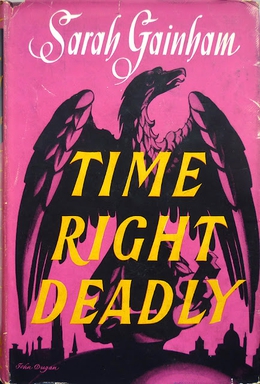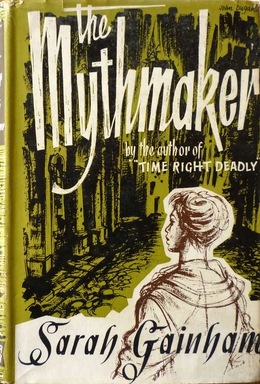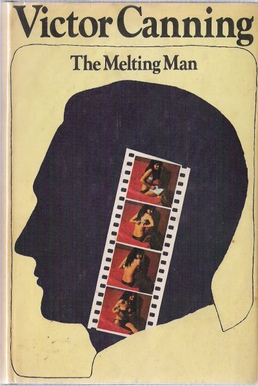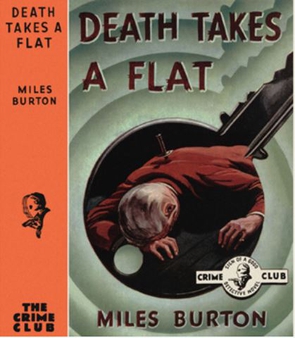
Panther's Moon is a 1948 spy thriller novel by the British writer Victor Canning. It was his second post-war novel, following The Chasm, as he had largely been taken a break from writing during his wartime service.

Time Right Deadly is a 1956 thriller novel by the British writer Sarah Gainham. Her debut novel, it was shortlisted for the Gold Dagger Award, losing out to Edward Grierson's The Second Man. Like many of her novels it takes place in post-war Austria, where she lived.

The Stone Roses is a 1959 spy thriller novel by the British writer Sarah Gainham. It is set in Prague shortly after the Communist coup in Czechoslovakia.

The Cold Dark Night is a 1957 spy thriller novel by the British writer Sarah Gainham. Her second novel, it is set at the height of the Cold War when the 1954 Berlin Conference saw the Big Four foreign ministers arrive in the divided city. Gainham had worked in Berlin as a journalist at the time of the Conference.

The Mythmaker is a 1957 spy thriller novel by the British writer Sarah Gainham, her third published novel. At with many of her works it takes place in Vienna, where she settled in the post-war era. It was released in the United States in 1958 under the alternative title Appointment in Vienna.

The Silent Hostage is a 1960 spy thriller novel by the British writer Sarah Gainham. Before writing her most celebrated work Night Falls on the City, Gainham produced several thrillers set in Continental Europe where she had lived since 1947. The novel takes place on the Adriatic Coast of Yugoslavia not long after the Second World War.

The Vanishing Corpse is a 1941 mystery thriller novel by Anthony Gilbert, the pen name of British writer Lucy Beatrice Malleson. It is the eighth in her long-running series featuring the unscrupulous London solicitor Arthur Crook, one of the more unorthodox detectives of the Golden Age. It was published in the United States under the alternative title She Vanished in the Dawn.

A Forest of Eyes is a 1950 spy thriller novel by the British writer Victor Canning. Stylistically it owed a debt to Canning's friend, the writer Eric Ambler.

The Chasm is a 1947 thriller novel by the British writer Victor Canning. It was his first novel since the Second World War during which he had served in the Royal Artillery and was largely absent from the writing world. The novel is inspired by the events of the partisan republic of Corniolo, on the Forlì Apennines. He increasingly turned to espionage and crime novels. It takes place in Italy where Canning had served during the Italian campaign.

Green Battlefield is a 1943 war thriller novel by the British writer Victor Canning. It was published by Hodder & Stoughton and was the only novel he wrote during his military service in the Royal Artillery. Although comparatively successful, and reprinted in 1944, Canning himself was later dismissive of the novel saying "It was a topical book. I spun it off to cash in on the war story thing. It was quite a competent story, but nothing I’d want in the canon of works!." Nevertheless, it was translated into Italian and French, the first time his work had appeared in those languages.

Queen's Pawn is a 1969 thriller novel by the British writer Victor Canning. The title is a reference to the chess opening of the same name and the fact that much of the novel's action centres around the Queen Elizabeth 2 ocean liner. It was his first novel after finishing the Rex Carver series of spy adventures.

Doubled in Diamonds is a 1966 spy thriller novel by the British Victor Canning. It is the second in a series of four novels about Rex Carver, a private detective drawn back into his old profession of espionage.

The Python Project is a 1967 spy thriller novel by the British Victor Canning. It is the third in a series of four novels about Rex Carver, a private detective drawn back into his old profession of espionage. A complex plot which involves a jewel robbery and the exchange of prisoners between the British and Soviet intelligence services takes place in a variety of locations including London, Paris, Libya and the Balearic Islands.

The Melting Man is a 1968 thriller novel by the British Victor Canning. It is the fourth and final entry in a series novels about Rex Carver, a private detective drawn back into his old profession of espionage. It features the French secret agent Aristide de la Dole, who had previously appeared in Doubled in Diamonds.

Firecrest is a 1971 spy thriller novel by the British writer Victor Canning. A stand-alone novel, it introduced a more modern, darker and naturalistic style compared to Canning's previous novels. It marked the first appearance of "The Department", a shadowy dirty tricks agency working for the British government which featured in subsequent novels.

Death Takes a Flat is a 1940 detective novel by the British writer Cecil Street, writing under the pen name of Miles Burton. It was the twenty-third in a series of books featuring the detective Desmond Merrion and Inspector Arnold of Scotland Yard. It was published in the United States by Doubleday under the alternative title Vacancy with Corpse.

Mr. Westerby Missing is a 1940 detective novel by the British writer Cecil Street, writing under the pen name of Miles Burton. It was the twenty-second in a series of books featuring the detective Desmond Merrion and Inspector Arnold of Scotland Yard. It was published in the United States by Doubleday the same year.

The Crouching Beast is a 1928 spy thriller novel by the British author Valentine Williams. It is part of his series of novels and short stories featuring the character of "Clubfoot", the alias of Doctor Adolph Grunt a brilliant but sinister German secret service mastermind. It is set in Constantinople, capital of the Ottoman Empire, during the First World War.

Courier to Marrakesh is a 1944 spy thriller novel by the British author Valentine Williams. It is the last in his series of novels featuring the character of "Clubfoot", the mastermind of the German secret service. While the character had initially appeared in stories set during the First World War, the final novel updated the series to the Second World War.

The Man with the Clubfoot is a 1918 spy thriller novel by the author Valentine Williams. It is the first in his series of novels featuring the character of "Clubfoot", Germany's top secret agent Doctor Adolph Grunt. He is pitched against Desmond Okewood, a young officer employed by British intelligence. It was followed by several sequels.




















